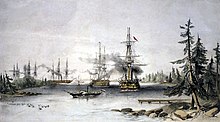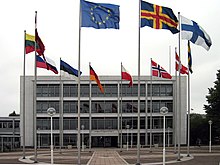Politics of Åland
This article needs additional citations for verification. (March 2010) |
 |
|---|
Politics of the
The Åland Islands are governed according to the Act on Åland Autonomy and international treaties, which guarantees autonomy and demilitarized status. The
In 1634, Åland was made part of the
During the Civil War in 1918, some Russian troops were still stationed on the islands, causing serious instability and nervousness. This anxiety in the local population, and the other Scandinavian states, resulted in a Swedish occupation and 7,135 people (of a total population of approximately 22,500 at the time) signing the address for Åland joining the kingdom of Sweden. The fear of Russia finally resulted in a German occupation of the islands. In the meantime, the Finnish press was playing with the idea of an exchange of land areas between Sweden and Finland. The areas in question of this exchange would have been the Swedish-speaking Åland to Sweden and some Finnish-speaking areas of Norrbotten and Västerbotten to Finland. The response from the Swedish government was bluntly negative to any exchanges of this nature.
Since the 1920s, the primary political issue in Åland Islands relates to the promotion and protection of the self-government of the islands.
In 1921 the question of Åland was brought to the council of the
Åland has its national flag, has issued its
Until the late 1970s, Åland politics was predominantly personalised, as politics was oriented around notable individuals.[1] In the late 1970s, a party system developed.[1] The prominent parties in Åland since 1979 are the Social Democrats, Centre, Liberals, and Moderates.[1] In comparison to the other Nordic countries, the political left is weak in Åland.[1]

Executive branch

| Office | Name | Party | Since |
|---|---|---|---|
| Lantråd | Katrin Sjögren | Lib | 2015 |
| Other Government parties | MSÅ, ÅS |
In addition to Åland's government, the
Legislative branch
The Parliament of Åland (Lagtinget, which means Law Thing) has 30 members, elected for a four-year term by proportional representation.
Political parties and elections
Local government
- Municipalities of Åland, or Kommuner
See also
- Politics of Finland
- Ting
- Swedish Assembly of Finland, or Folktinget
References
External links
- [1] – Official site
- Landskapsregeringen – Official site
- Act on Åland Autonomy – at Lagtinget

